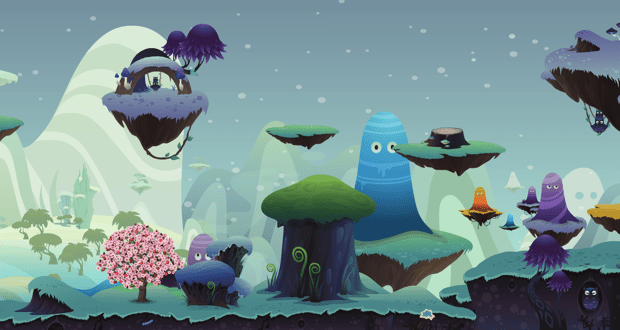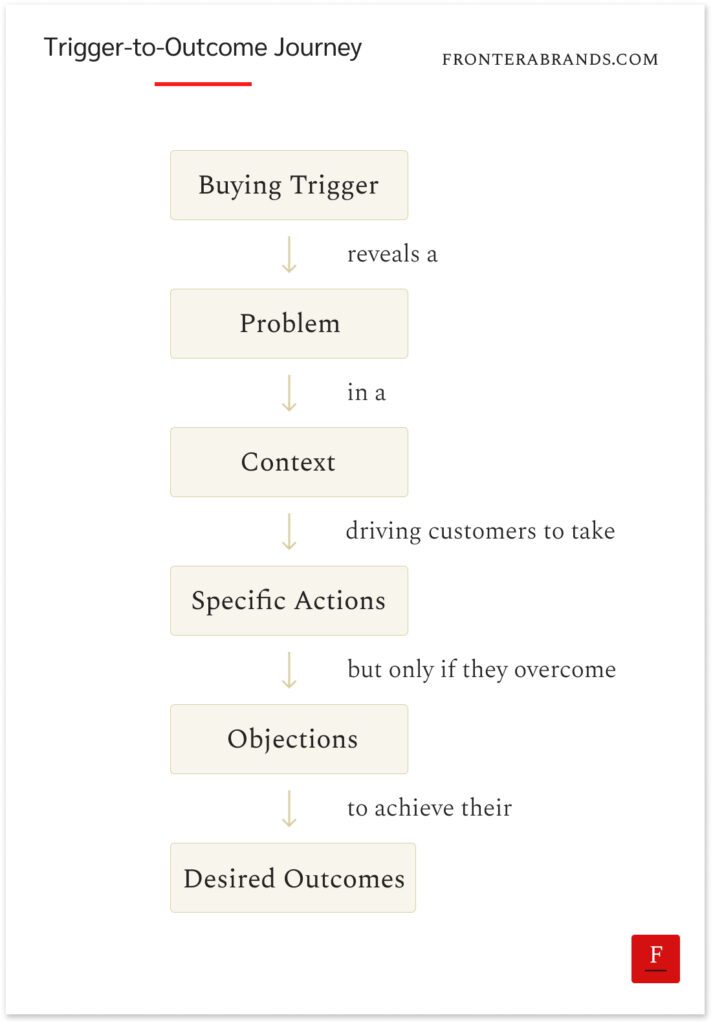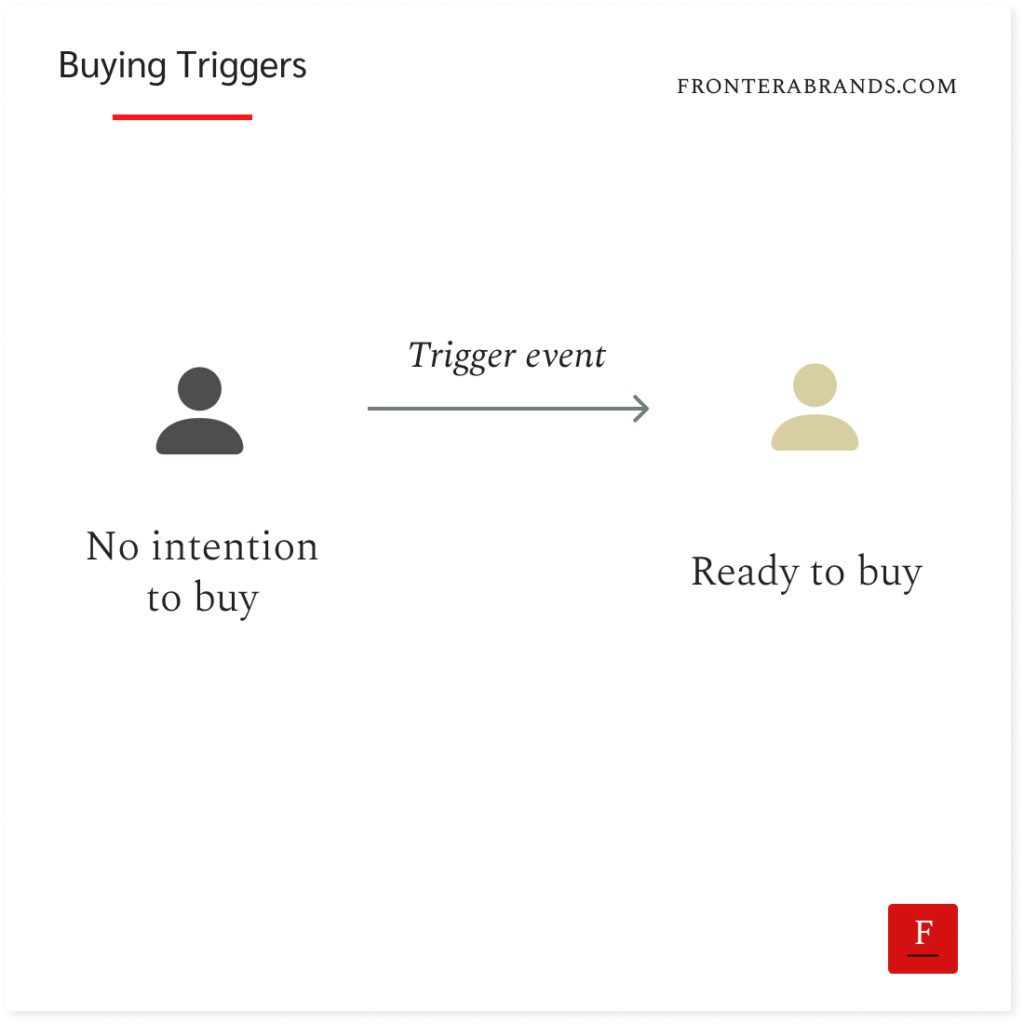We’ve talked about the 3C’s that drive a brand’s positioning in our Profit-Led Branding Framework:
Company, Competition, and Customer.
In this article, we’ll look into the last C: Customer.
There are two parts of Customer Analysis.
We’ll cover the “What are our customers trying to achieve?” part here.
The second part “Who are the customers trying to make that progress?” is for another day.
Now let’s see why Slack was about to fail as a “group chat app”, how positioning increases perceived value, and how to make your brand something customers want:
–
In 2012, Stewart Butterfield realized his gaming startup was bound to fail.
They tried to make their game Glitch successful for a long time.
They added new features, new designs, new storylines…
Nothing worked.
But there was one thing.
While developing the game, they built a group chat app to improve team collaboration.
And as they were a gaming company, their developers gamified features.
It was unlike any other group chat app.
It was fun to use.
And their teams loved it.
Since the game was failing anyway, Butterfield decided to salvage this app and try selling it to other companies.
So he closed the gaming side and pivoted the business.
They called the new product Slack.

Slack went live in 2013.
And as Butterfield was a known entrepreneur thanks to his previous startup Flickr, a lot of people started using its free version from the first day.
So they gained some early traction.
But soon they started receiving some feedback.
The product was fine.
Just like the Slack team, other users also enjoyed using it.
The problem was when the directors and CTOs of those users had to upgrade from free to paid.
Those decision-makers didn’t see the value of Slack.
They all had other group chat tools.
Why would they pay for another one?
So even though they got some startups as customers, Butterfield realized they had a problem.
If they couldn’t communicate the value of Slack, they were not going to grow.
But even he had the question: what was the real value of Slack?
So Butterfield started seeking an answer.
He talked to his team.
He talked to customers who loved Slack.
And he talked to users who liked Slack but didn’t buy the paid version.
After a few weeks, he found his answer.
No matter how fun and beautiful it was, nobody wanted to pay for another internal group chat app.
So selling Slack as a group chat app was suicide.
But Butterfield also realized Slack was beyond a group chat app.
Customers who fully adopted Slack said they needed fewer meetings and emails.
They could track all their work, files, and conversations in one place.
And they said their team members felt less stressed thanks to Slack.
So Slack was not a group chat app.
Slack was a new way of working.
And if they positioned Slack as a tool that enabled a more efficient, less stressful way of working, customers would perceive it as much more valuable.
Butterfield shared his ideas about Slack’s real value and its new positioning in a Medium post that became famous in 2014.
He used the metaphor of an imaginary saddle company.
A saddle company could sell saddles and compete on material, style, or price.
Or they could sell horseback riding.
And he made his decision obvious with the title of the post: “We don’t sell saddles here.”
Understand your customers to give them something they want
We all know the rest of Slack’s story.
They reached 10+ million daily active users in 2021 and were acquired by Salesforce for $27.7 billion.
But let’s think together for a second.
Slack’s new positioning proves one thing we repeatedly talk about.
A brand can become drastically more valuable to customers with a different frame.
And positioning is about finding that.
Butterfield found it for Slack and the same product magically became more valuable to customers.
But finding that magical frame is not that easy.
You must know customers better than they know themselves.
And that’s why one of the three C’s that drive positioning in our framework is Customer.
We analyze what customers are trying to achieve using the Trigger-to-Outcome Journey.
So we can find the ideal positioning that will make the brand more valuable.
There are six ingredients.
I’ll use the Slack example to explain them:

1. Buying Triggers
“What are the events that make customers aware of the problem?”
We talked about Eugene Schwartz’s customer awareness levels in the Framing Effect article.
Not all your potential customers are aware that they have a problem.
They might experience it — but they might be accepting the situation as normal since it’s not so pressing yet.
In other words, they are problem-unaware.
An executive might have a feeling that they need to improve their marketing — but don’t see it as a problem yet as they still get customers through word-of-mouth.
But one day, something happens.
It can be receiving a weak quarterly result, a meeting with the sales team, or hearing about a competitor’s growth rate.
That event —the buying trigger— reveals the problem to that executive.
So now the executive starts looking for solutions to fix it.

Buying triggers are important because they start the customer’s buying journey.
When you know your customers’ triggers, you can associate your brand with those moments.
Like Rolex did by becoming a symbol of a milestone of success.
In Slack’s case, the buying triggers could be:
- Missing an important message buried in an email thread
- Jumping between five different platforms to get information for a presentation
- Reading an article about the real cost of inefficient team collaboration
2. Problem
“What’s the main problem we solve for customers?”
Every brand exists to solve a problem in customers’ lives.
But sometimes, two things happen.
Brands either choose a weak customer problem to solve.
Or they choose an important problem but don’t communicate it the right way.
And it causes customers to undervalue that brand.
That’s why you have to get clear on the problem your brand solves for customers, from their perspective.
At the beginning, customers thought Slack was solving this problem:
“The internal group chat apps are boring.”
So they didn’t care much.
But Butterfield realized there was a more important problem Slack could solve:
“The way teams collaborate is inefficient and stressful.”
Much more important, right?
The right positioning cannot be born from the wrong problem.
So when you clarify the main problem your brand solves, use these two questions to validate it:
- Do we solve an important problem for our customers from their perspective?
- Do we convey the problem we solve accurately? Or do they think we solve another problem than the one we intend to solve?
3. Context
“In what context do they use our products and services?”
The same product or service can mean different things to the customer depending on the context.
A watch shows you the time.
But are you wearing it to an important meeting to close a deal?
Or are you measuring your running time?
Or are you taking it to the moon like Omega Speedmaster and it has to work under those conditions?
Context changes everything.
We’ve talked about McDonald’s milkshakes many times.
A milkshake is a milkshake.
But a person who buys a Milkshake as a morning snack while driving to work or a mother buying it for her kid as a dessert is trying to achieve different outcomes.
So understanding in what context your product or service is being used is crucial.
Because it allows you to understand what they are really trying to achieve.
So you can tailor your products and message to their context.
In Slack’s case, the context was:
- When team members work on multiple projects with different people
- When team members work remotely or from different locations
- When teams use multiple platforms
4. Specific Actions
“In that context, what are the specific actions they have to take to fix the problem?”
So this is where your solution fits in.
Customers have to take specific actions to fix the problem.
For a web development agency’s customer, the action can be revamping their website.
For a management consultant’s customer, the action can be creating an outsourcing strategy.
In Slack’s case:
- Create channels for different projects/teams
- See all archived conversations and documents in a channel
- Integrate work tools to collaborate in one place
5. Objections
“What are the beliefs that prevent them from achieving the desired outcomes?”
Every salesperson knows this.
Potential buyers always have objections.
And you have to “handle” these objections in sales calls to close a sale.
But here’s the thing.
Positioning and messaging allow you to handle major objections at scale.
Slack’s previous positioning didn’t handle any objections.
It created even bigger ones.
So if you know your customers’ main objections, you can address them with your positioning.
Now, customers have generic objections to all companies they consider buying from.
Like “How can I trust you?” or “What if you don’t deliver?”
These objections can be handled with social proof, testimonials, guarantees, etc.
But for finding your positioning, look for objections specific to your solution.
These questions might help you uncover them:
- Which concerns come up repeatedly in your sales conversations?
- What do prospects say when they decide not to buy?
- What misconceptions do people have about your solution?
In Slack’s case, they were:
- “We don’t need another internal chat app.”
- “It’s just another distraction.”
- “It’s too expensive compared with other chat apps.
6. Desired Outcomes
“What are the desired outcomes customers trying to achieve by fixing the problem?”
Customers go through this buying journey for results — in other words Desired Outcomes.
They have these outcomes in their minds even from the beginning.
They want to solve the Problem.
So they can realize the Desired Outcomes.
And as we discussed in the Jobs-to-be-done framework, functional outcomes are only one aspect.
There are also emotional and social outcomes that drive customers.
If you know them, you can position your brand as a path to those outcomes.
And your messaging becomes potent.
In Slack’s case, customers were after these outcomes:
Functional
- Save time from endless emails and meetings
- Keep all communications organized by project
- Save time switching between tools
Emotional (”What do I want to feel?”)
- Reduce stress thanks to fewer meetings and emails
- Feel confident that nothing important is missed
- Peace of mind about team alignment
Social (”What do I want others to feel/become?”)
- Be seen as a modern, efficient team
- Improve team collaboration and engagement
- Create a stronger team culture even for employees who work from different locations
Would Slack have succeeded if they continued being a group chat app?
Probably not.
Customers didn’t want another group chat app.
But Butterfield dug deeper.
He understood customers’ perspectives — their problem, their objections, their desired outcomes.
Only then did he find positioning that made the same product much more valuable to customers.
Slack was not an internal chat app.
It was a new way of doing work.
Its position was right against email.
The moral of the story?
Positioning is about customers first.
Use Trigger-to-Outcome Journey to analyze their perspective.
The better you understand their world, the easier you can make your brand something they want.
–
Enjoyed this article?
Then you’ll love the How Brands Win Newsletter.
Get the “7 Positioning Sins That Cost B2B Brands Millions” guide when you join. It’s free.

